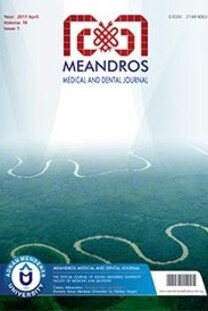ADNAN MENDERES ÜNİVERSİTESİNDE İZLENEN ZEHİRLENME OLGULARI
Akut zehirlenme, acil servis, intoksikasyon, yoğun bakım, erişkin
Epidemiology of Adult Poisoning at Adnan Menderes University
Acute poisoning, emergency department, intoxication, intensive care unit, adults,
___
- 1. La patt o -Rei nil u ot o O. Ac ute p oi s o ni n g s: Epidemiology and gastrointestinal decontamination. Helsinki Hakapaino. 2001: 11-4 (http://ethesis.helsinki.fi)
- 2. Turvill JL, Burroughs AK, Moore KP. Change in occurrence of paracetamol overdose in UK after introduction of blister packs. Lancet 2000; 355: 2048- 2049.
- 3. Hawton K, Ware C, Mistry H, Hewitt J, Kingsbury S, Roberts D, Weitzel H. Paracetamol self-poisoning. Br J Psych 1996; 168: 43-48.
- 4. Cabo Valle M, Marti Lloret JB, Miralles Gisbert S, Marti Ciriquian JL. Etiology of intoxication: A study of 557 cases. Eur J Epidemiol 1993; 9: 361-3.
- 5. McLoone P, Crombie IK. Hospitalisation for deliberate self-poisoning in Scotland from 1981 to 1993: Trends in rates and types of drugs used. Br J Psych 1996; 169: 81-85.
- 6. Abdollahi M, Jalali N, Sabzevari O, Hoseini R, Ghanea T. A retrospective study of poisoning in Tehran. Clin Toxicol 1997; 35: 387-393.
- 7. Mokhlesi B, Leiken JB, Murray P, Corbridge TC.Adult toxicology in critical care; part I: general approach to the intoxicated patient. Chest 2003; 123: 577592.
- 8. Akköse Ş, Fedakar R, Bulut M, Çebiçci H. Zehirlenme Olgularının Beş Yıllık Analizi, Acil Tıp Dergisi 2003; 3: 8-10.
- 9. Kekeç Z,AvşaroğullarıL,İkizceliİ, Kurtoğlu S, Sözüer E. Erciyes Üniversitesi Tıp Fakültesi Hastaneleri Acil Servisine Başvuran Hayvansal Zehirlenme Olgularının İncelenmesi,Acil Tıp Dergisi 2003; 3: 45-48.
- 10. Özköse Z, Ayoğlu F. Etiological and demographical characteristics of acute adult poisoning in Ankara, Turkey. Hum Exp Toxicol 1999; 18: 614-618.
- 11. Göksu S, Yıldırım C, Koçoğlu H, Tutak A, Öner U. Characteristics of acute adult poisoning in Gaziantep, Turkey. J Toxicol Clin Toxicol. 2002;40: 833-7.
- 12. Kaygusuz K, Kılıççıoğlu F, Gürelik B, Gürsoy S. Yo ğ un bak ı m ünitelerinde akut ilaç intoksikasyonlarının retrospektif analizi. Türk Anesteziyoloji ve Reanimasyon Derneği Dergisi 2003: 31: Ek sayı 2:132
- 13. McGrath J. A survey of deliberate self-poisoning. Med JAust 1989; 150: 317-324.
- 14. Liu Y, Wolf LR, Zhu W. Epidemiology of adult poisoning at China Medical University. Clin Toxicol 1997; 35: 175-180
- 15. Thomas SHL, Bevan L, Bhattacharyya S, Bramble MG, Chew K, Connolly J, Dorani B, Han KH, Horner JE, Rodgers A, Sen B, Tesfayohannes B, Wynne H, Bateman DN. Presentation of poisoned patients to accident and emergency departments in the North of England. Hum Exp Toxicol 1996; 15: 466-470.
- 16. Mokhlesi, B; Leiken JB; Patrick Murray, Corbridge TC. Adult Toxicology in Critical Care Part I: General Approach to the Intoxicated Patient Chest 2003; 123:577592
- ISSN: 2149-9063
- Yayın Aralığı: 4
- Başlangıç: 2000
- Yayıncı: Aydın Adnan Menderes Üniversitesi
DOĞUMSAL ÇİFT DUDAK DEFORMİTESİ: 8 OLGUNUN SUNUMU
Eray COPCU, Nazan SİVRİOGLU, Yücel ÖZTAN
F. Serdar GÜREL, Ayfer GEMALMAZ, Güzel DİŞÇİGİL
DOWN SENDROMLU BİR OLGUDA BAZAL GANGLİYON KALSİFİKASYONU
Tanıl KENDİRLİ, Bahar Emine BİNGÖLER, Ercan TUTAR, Erdal İNCE, Gülhis DEDA
ACİL SERVİSE BAŞVURAN MANTAR ZEHİRLENMELERİNİN RETROSPEKTİF OLARAK İNCELENMESİ
Çiğdem ECEVİT, Murat HIZARCIOĞLU, Pelin Akgün GERÇEK, Hakan GERÇEK, Ertan KAYSERİLİ, Pamir GÜLEZ, Hurşit APA
Ali K. ADİLOĞLU, M. Cem ŞİRİN, Buket CİCİOĞLU-ARIDOĞAN, Rabia CAN, Mustafa DEMİRCİ
TONSİLLEKTOMİ/ADENOTONSİLLEKTOMİ CERRAHİSİNDE KETAMİNİN PREEMPTİF ANALJEZİK ÖZELLİKLERİ
Osman Nuri AYDIN, Bakiye UĞUR, Sanem ÖZGÜN, Hülya EYİGÖR, Özgen COPCU
FOTOSENSİTİZE EDİLEN ERİTROSİTLERDEKİ HEMOLİZ KİNETİK MODELİ: ÇOK VURUŞLU HEDEF TEOR
Mehmet Dinçer BİLGİN, A. Eser ELÇİN
MİTRAL KAPAK REPLASMANI SONRASI GELİŞEN ENDER YERLEŞİMLİ PERİPROSTETİK KAÇAK: Olgu Sunumu
M. İsmail BADAK, Uğur GÜRCÜN, Mehmet BOĞA, Erdem Ali ÖZKISACIK
Complications in Modified Bristow Procedure
